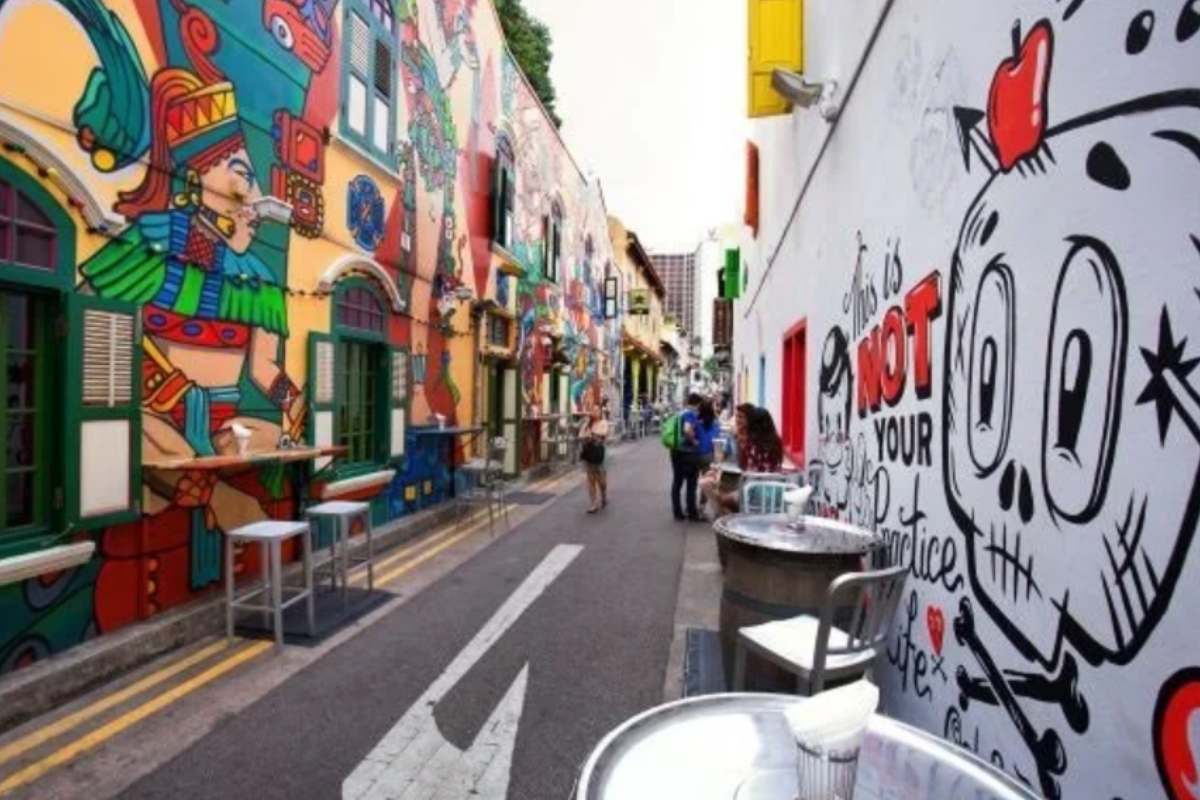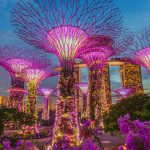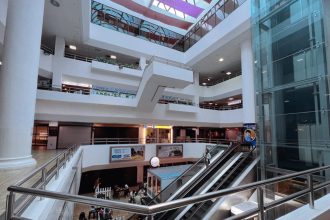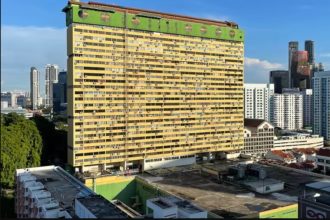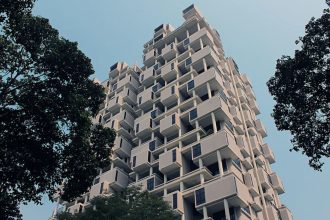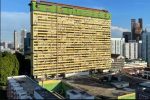Key takeaway
Haji Lane’s street art does more than dazzle the eyes. It reflects Kampong Glam’s layered identity, from its humble roots as a pilgrimage alley to a hub of multicultural expression. The murals speak across cultures, weaving together history, creativity, and community in Singapore’s most colorful little lane.
Walking into Haji Lane feels like stepping into an open-air gallery. The walls here burst with color and meaning, but this is more than just pretty pictures. The street art along this narrow alley offers a powerful story about who Kampong Glam is, and how its identity has changed. Every mural seems to invite passersby to pause, reflect, and engage with the history embedded in the shophouses that line the street.
The Origins of Haji Lane
Long before murals, Haji Lane was a practical passageway. Pilgrim‑brokers helped Muslims prepare for the Hajj, and shophouses served as lodging for pilgrims. Over time, the area quieted down. By the 1960s and 70s, many of the shophouses were underused or abandoned. Then, in the 2000s, artists, designers, and small‑business owners revived the street with creativity, turning Haji Lane into a colourful, vibrant enclave. Boutique stores, cafés, and independent fashion outlets added to the street’s charm, giving locals and tourists alike reasons to linger.
Haji Lane Mural: How Street Art Anchors Cultural Identity
The murals don’t just decorate the lane; they anchor its cultural identity. Each piece has meaning, often tied to heritage, personal stories, or shared memory. Visitors can see themes of migration, trade, and spirituality woven into the imagery, reflecting Kampong Glam’s historic role as a diverse neighbourhood.
Jaba’s Aztec Masterpiece at Piedra Negra
At the corner of Haji Lane and Beach Road, you’ll find a mural by Didier “Jaba” Mathieu. It’s a stunning tribute to Aztec civilization, tall figures, vibrant symbols, and rich, jewel‑toned patterns. The artwork helped spark Haji Lane’s street art scene. Jaba’s signature style reflects his background as a concept artist and his worldly influences. His work also encourages younger local artists to experiment, making Haji Lane a hub for creative collaboration and mentorship programs.
Faces from the Past by Ceno2
Across other parts of the lane, Ceno2 (Mohammad Azlan Ramlan) created a monochrome mural called “Faces From the Past.” It features a turbaned elder, a Samsui woman, and a Malay man, quietly powerful; it honors Singapore’s multicultural heritage. The mural resonates with older generations who remember the lane’s original community. For visitors exploring the broader area, the heritage district streets around Bukit Pasoh Road offer a complementary experience of preserved shophouse architecture, connecting past and present urban life.
Batik Graffiti and Singapore Identity
Hidden down the alley between Haji Lane and Arab Street is another form of expression: batik-inspired graffiti by Slac Satu and Zinc Nite Crew. The patterns connect to traditional textile heritage while also bringing fresh artistic styles to the streets. The interplay between old motifs and modern execution shows how traditional Singaporean identity can be reinterpreted through street art.
Why Haji Lane Mural Matters to Local Culture
The presence of murals in this conserved heritage zone did not always go unchallenged. URA (the Urban Redevelopment Authority) flagged one mural in 2012 because its colours did not align with guidelines for conserved shophouses. Still, a compromise was reached, enforcing heritage rules while allowing creativity to flourish. That outcome showed how art and heritage can work together, not just collide. Those interested in Singapore’s dining and street culture can also visit Singapore’s largest hawker centre at Chinatown Complex for a different perspective, sampling flavours that have endured alongside the neighbourhood’s evolving art scene.
Street Art as a Bridge Between Cultures
The murals on Haji Lane say so much about cultural identity. They are not just decorative, but narrative. Here are some ways they connect communities:
- Heritage meets global influence. Jaba’s Aztec art links Singapore to Latin America, showing how local spaces can host international ideas.
- Honouring the past. Ceno2’s portraits pay tribute to older generations and ethnic traditions, reminding viewers where Kampong Glam came from.
- Community participation. The support from business associations and arts bodies shows that street art is deeply rooted in local civic life.
- Dynamic public space. The murals evolve, sparking fresh conversations every time someone walks the lane.
Haji Lane Mural: Engaging With Art Beyond the Walls
Many shops along Haji Lane also host workshops, temporary exhibitions, or artist talks. Visitors can engage with creators directly, learning techniques or the stories behind specific murals. Art walking tours often include interactive sessions where participants sketch walls or contribute small murals. This participatory culture strengthens ties between residents, visitors, and artists, giving each mural a life beyond its paint.
A Walk-Through Guide
If you want to feel that connection between art and place, here is a quick way to take in Haji Lane’s murals:
- Start at the junction of Beach Road and Haji Lane. Look up at the Jaba Aztec mural on Piedra Negra. Let the symbolism sink in.
- Walk slowly down Haji Lane. Pause at the shophouse walls and try to spot more murals: Jaba’s pieces, batik graffiti, and others.
- Turn into the alley that links Haji Lane and Arab Street. There, you will find batik graffiti by Slac Satu / ZNC crews.
- Stop by The Singapura Club at 36 Haji Lane. The black‑and‑white “Faces From the Past” by Ceno2 is a moment for reflection.
- Stay a little. Find a café or bar. Enjoy how the art and the community mix, not just for photos but for living.
Fast Facts About Haji Lane Mural
| Location / Wall | Artist & Style | Cultural Relevance |
|---|---|---|
| Piedra Negra, corner of Beach Road & Haji Lane | Didier “Jaba” Mathieu – Aztec-inspired mural | Brings Latin American indigenous culture into a heritage street |
| Wall along Bali Lane / Near Blu Jaz Café | Jaba – bright, layered compositions | Symbolises the creative rebirth of old shophouses |
| Alley linking to Arab Street | Slac Satu / Zinc Nite Crew – Batik graffiti | Fuses traditional textile motifs with street art energy |
| 36 Haji Lane, Singapura Club | Ceno2 – Monochrome portraits (“Faces From the Past”) | Reflects local generations and multi-ethnic heritage |
Why Haji Lane Mural Connects Communities
The street art on Haji Lane is not trendy decor. It is a living narrative of Kampong Glam’s past and present, a visual conversation across cultures. Whether you pause at Jaba’s Aztec imagery, Slac Satu’s batik graffiti, or Ceno2’s faces, you’ll sense something deeper: this is where heritage is not just preserved. It is reinterpreted, shared, and celebrated. Visitors who wish to understand the area further can explore the historic Kampong Glam precinct to see how the murals fit into Singapore’s broader cultural story. The murals also encourage dialogue between generations, inviting younger audiences to connect with older cultural practices in a contemporary context. Over time, these artworks help solidify a sense of belonging and community pride among residents and visitors alike.
The Future of Public Art in Kampong Glam
As Singapore continues to grow, Haji Lane serves as a model for integrating street art into heritage conservation. Plans to introduce rotating murals, interactive light installations, and augmented reality experiences are being explored. Such initiatives aim to keep the lane dynamic, bridging past and present, while supporting local artists. The street’s ability to evolve while respecting history shows how creative urban spaces can remain culturally relevant and vibrant over time. Visitors and locals alike are encouraged to engage with each mural as it changes, experiencing the stories anew. With growing interest from the arts community, Haji Lane is poised to remain a focal point for creativity and cultural dialogue in Singapore.
